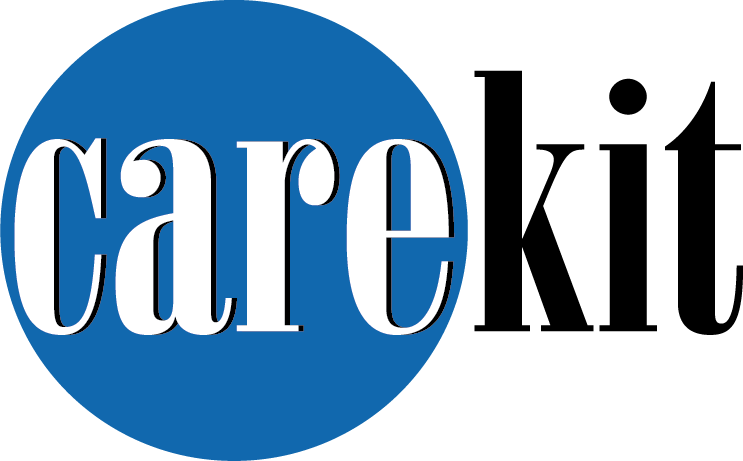A New Approach
Old methods to engage patients rarely worked. As healthcare moves more and more to value-based care, providers know that engaging patient’s from their point-of view using language and tools they understand will drive results. Done right, effective approaches to patient engagement will:
- Develop patient trust & credibility
- Increase satisfaction and star ratings
- Motivate and encourages patients
- Drive understanding and self-management of the care plan
- Reduce readmissions and the cost-of-care
Care Kits Are Different
We’ve made it our mission to develop patient engagment tools that cut through the clutter and drive action.
Our intense observation of patients at home and with providers has revealed barriers and keys to successful self-care while also exposing gaps in other methods. These insights form a new approach − the CSI Curriculum − proven to radically improve outcomes at lower cost. Our team of expert educators and medical professionals have done the heavy lifting by assembling the curriculum, tools and devices that patients need to manage their own self-care. Patients receive a condition-specific roadmap for self-care that is rooted in the latest clinical best practices and adult learning principles written to 3rd and 4th grade reading level. Best of all, providers can co-brand and customize Care Kits. This improves outcomes and promotes your brand all at the same time.
Hospitals
Up until recently, patient education was not seen as much more than handing out simple pamphlets or having a “quick” chat with the patient prior to discharge. Sometimes patients receive photocopied materials or printouts from an EHR, but even then, most of these materials are outdated and hard to understand – especially by someone still disoriented from their hospital stay. Patients can do far more than you ever dreamed possible when they have self-care materials designed from their point-of-view along with the right tools and devices. This will result in lower readmission rates, a more efficient staff and higher HCAHP scores. The best names in teaching and community hospitals already know this. Hospitals that use Care Kits achieve results.
 Providers that use Care Kits achieve:
Providers that use Care Kits achieve:
- Up to 74% lower readmissions
- Improved medication compliance post-discharge
- 144% improvement in standardization of staff time teaching patients
- Over 95% patient satisfaction rates
“Everything to engage patients is in one place. I know they have all they need from day one [to help prevent a readmission].”
– CNO, Regional Hospital
Post-Acute Providers
Care Kits are especially useful to post-acute and transitional care providers such as Home Care, Home Health and Short Term Rehabilitation facilities who work with patients following an acute care hospital stay. Care Kits are an indispensable tool that providers use to make patients independent for long-term self-care as they transition to home.
Care Kits help Post Acute providers:
- Prevent readmissions & ER visits
Fifteen years of studies show Care Kits prevent lapses in self-care that lead to readmissions. - Gain referrals from facilities, ACOs & MCOs
Use Care Kits to differentiate your services. Show them to discharge planners and other referring providers and watch your census grow! - Earn back HHVBP Model incentives
OASIS and HHCAHP scores will skyrocket as your patient satisfaction and outcomes improve. - Continue patient care when tele monitoring ends
Care Kits stay with the patient – telemonitoring doesn’t. Telemonitoring is short-term support. Care Kits are long-term independence. - Differentiate your CCJR program
Our Post Hip & Knee and Falls Prevention Care Kits will show hospitals you provide a more complete patient experience.
“Care Kits are an HHVBP Model Game Changer.”
– Director, Home Care Agency
“What a relief. All of our staff is coaching patients with the same tools and materials. Training and field work is streamlined and we know we are using best-of-class materials.”
– Administrator, Home Care Agency
Health Plans
Communicate, Communicate, Communicate. Health plans use Care Kits to cut through the clutter and engage members to become active participants in their health. Old methods of care management simply don’t work. When care managers send pamphlets, or worse, attempt to guide members without any materials at all, members feel disengaged and confused. It’s time to engage members from their point of view using language and tools they understand. Care Kits help members and their case managers share a common set of clear and concise tasks that can be integrated easily into any care management process. Care Managers know exactly what to teach and how to coach it. Members know exactly what to do and when to do it. The result?
- Improved HEDIS and Star Ratings
- Lower overall cost of care due to lower ER rates, higher meds compliance, and improved outcomes
- Increased loyalty and retention
- Improved efficiency and utilization of your care management team
Employee Wellness
 Businesses know the financial benefits of promoting a healthy and productive work force but struggle with cost-effective and employee-friendly interventions. Companies are challenged to create a culture of health & wellness and still give employees the freedom to integrate healthy choices that work for them. Care Kits work because they give employees the knowledge, tools and supplies that help them make wise decisions tailored specifically to their condition. Care Kits are NOT ordinary brochures and pamphlets. Care Kits give employees and their families specific tasks and action plans they can integrate into their schedules at their own pace. If you speak their language and fit into their lives, you’ll get positive results. Employee wellness Care Kits include: Blood Sugar Control, Cholesterol Management, Weight Management, Blood Pressure Control, Back Fitness, Heart Fitness and others.
Businesses know the financial benefits of promoting a healthy and productive work force but struggle with cost-effective and employee-friendly interventions. Companies are challenged to create a culture of health & wellness and still give employees the freedom to integrate healthy choices that work for them. Care Kits work because they give employees the knowledge, tools and supplies that help them make wise decisions tailored specifically to their condition. Care Kits are NOT ordinary brochures and pamphlets. Care Kits give employees and their families specific tasks and action plans they can integrate into their schedules at their own pace. If you speak their language and fit into their lives, you’ll get positive results. Employee wellness Care Kits include: Blood Sugar Control, Cholesterol Management, Weight Management, Blood Pressure Control, Back Fitness, Heart Fitness and others.
Care Kits help Employee Groups lower overall healthcare cost and improve productivity:
- Reduce overall costs by over $56/pmpm.*
- Decrease absenteeism and increase productivity
- Improve communication between employees and their doctor
- Increase employee satisfaction
* Improved Cost, Health, and Satisfaction With a Health Home Benefit Plan for Self-Insured Employers and Small Physician Practices, Jerry Reeves, MD; Brian Kapp, BS, J Ambulatory Care Manage, Vol. 36, No. 2, pp. 108–120
